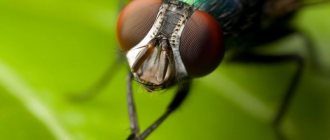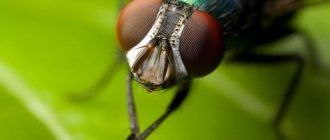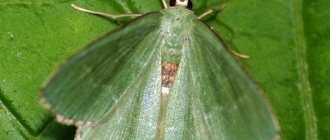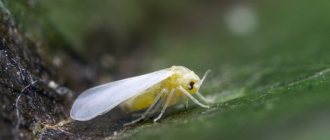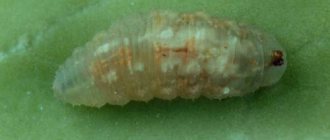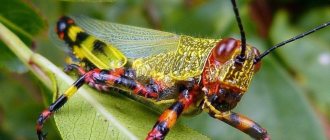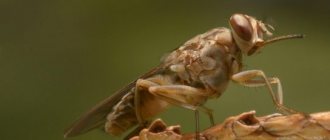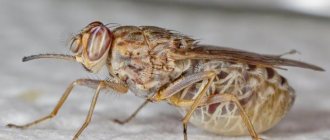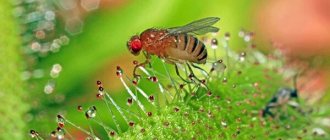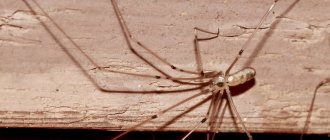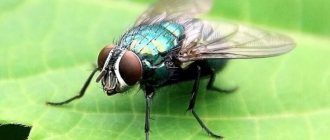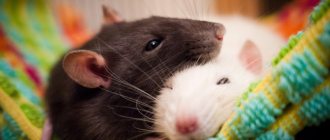Biologists know about six thousand species of syrphids. Most of them live in North America and Eurasia (with the exception of Central Asia). And two species are found even in the subarctic zone. In Africa, South America and Australia, these insects are almost absent.
Fly like a wasp
Hoverflies (lat. Syrphidae) are often found in vegetable gardens and summer cottages, where they actively pollinate flowers on garden and fruit crops.
On a note!
They are called hoverflies due to the sounds they make when flying, similar to the murmur of running water.
They are widespread and are found on all continents at positive air temperatures. According to biological classification, scientists place them in the order of short-whiskers and the family of Diptera.
Syrphids use a remarkable ability for mimicry, having an appearance very similar to the stinging insects of bees and wasps, having the same yellow and black striped abdomen, as seen in the photo of the hoverfly, thanks to which they escape from the attacks of birds and predators. Hoverflies are virtuosos in the “flight” business: their ability to hover or loiter in one place, and then break off and quickly fly away, is their distinctive feature. It is due to the unique structure of the wings: one pair is normal, and the second has been reduced over time into club-shaped halteres, which helps the insect maintain balance and control stopping in flight.
Male wasp flies have their own territory, which they vigilantly guard, periodically hovering in space. Even mating with females occurs in flight.
Externally, hoverflies resemble bees or wasps: they have an elongated body with a yellow belly and black stripes, some species have a black body with yellow spots.
On a note!
Due to the similarity of hoverflies to stinging insects, many are interested in the question of whether they bite. The answer may be information about the absence of not only a sting, but also poisonous glands. Therefore, they are absolutely harmless to humans.
Hoverfly
Description, distribution
The body length of the syrphid reaches on average 10-12 mm (in larger species - up to 25 mm). The legs are short, light, one pair of wings. The proboscis is not too long, the body is covered with barely noticeable fluff. The eyes are large, dark brown, the head is semicircular, slightly flattened. The color resembles that of wasps, bees or bumblebees: a dark abdomen with bright yellow oblong spots that look like stripes (there is one such stripe on each segment of the abdomen).
Hoverfly larvae are elongated, reminiscent of leeches, but slightly wrinkled. Their body is slightly narrowed at the front. In general, the larvae are slow, but their mobility increases sharply during the hunt (they make a very sharp lunge at the prey). Their color is greenish and transparent, which allows you to see the translucent internal organs. This stage lasts a month.
The pupae look like a drop of resin.
The eggs are white or with a pinkish (sometimes greenish or yellowish) tint, translucent, very small, develop in 2-4 days.
You can meet hover flies in Eurasia and North America (but not in its northernmost part). The main habitat of the syrphid is forest clearings, vegetable gardens, and fields, where it feeds on flower nectar or pollen.
Benefits and harms
The benefits or harms of hoverflies cannot be judged unambiguously. Much depends on the specific species living near gardening farms or agricultural fields. By feeding on insect pests such as aphids, the larvae of these flies preserve fruit trees and shrubs. And in mountainous areas where the number of bees is reduced, adult hoverflies are irreplaceable helpers for humans. By pollinating flowering cultivated plants, they increase their productivity.
But at the same time, some species are malicious pests of lily crops. By eating onions, garlic and damaging the bulbs of tulips, daffodils, hyacinth, the larvae create big problems for gardeners and flower growers. Damaged plants slow down and wither. And bulbs intended for storage quickly rot.
The rat flea is a carrier of such a serious disease as plague. You don’t know how to effectively get rid of scale insects on indoor plants? Then this article is especially for you.
Decontamination is a comprehensive measure aimed at cleaning a room or area from ticks. What means are used in this case, read the article at the link.
ladybugs
Even a child knows these cute, bright beetles. And here is something that would be useful for summer residents to know about them: ladybugs and their larvae are more active than many in destroying aphids, scale insects, and copperheads on the site. An adult insect eats several dozen aphids a day, and its larvae eat ten times more.
Ladybug larva
Thanks to this, ladybugs are literally necessary in every area, especially in gardens and flower beds, where aphids become a real scourge, destroying the leaves of apple trees, pears, roses and other plants.
Ladybugs wake up in the spring, actively feed and reproduce throughout the warm period, and with the onset of cold weather they look for shelter. To attract these insects to your site, you need to provide them with houses. For this purpose, both decorative industrial shelters and hollow stems tied in bunches, sprinkled with peat or sawdust, laid in secluded corners of the garden can be used.
- How to attract living helpers to the garden?
Don’t know how to fill your area with life and attract beneficial insects and birds? To do this, just follow a few tips.
Types of hoverflies
Such striped flies have many varieties: in the world - up to 60 thousand, in Russia their number is 800. All types of hoverflies are distinguished by the different arrangement of yellowish and black stripes, as well as the diet of their larvae: some of them are herbivores, others are predators, still others eat tree bark.
The most common of them:
- The common hoverfly or flower fly with yellow stripes, reaches 12 mm in length, is a good pollinator, the larvae of which destroy garden pests;
- Onion hoverfly (Delia antique) – its size is about 1 cm, the larvae feed on the juice and pulp of bulbous plants;
- Wasp fly (Temnostoma vespiform) - a fly similar to a wasp in coloring and body shape, size up to 18 mm, its larvae consume rotten wood;
- The tenacious bee fly (Eristalis tenax) is a fly similar to a bee, 15 mm long, darker in color;
- Aquatic hoverfly or eristalis fly (Eristalis) - lives near standing ponds, swamps or puddles with musty water, has a special proboscis for breathing in order to consume air from the surface;
- Tufted hoverfly wasp (fasciolatum).
Varieties
The following types of these flies are common in our country:
- Eristalis is an aquatic species of hoverfly. The larvae search the muddy bottom of puddles with musty water in search of food. All of them have a “tail” - a special breathing tube that allows you to breathe under water.
- Temnostoma vespiforme is distinguished by its external similarity to a wasp. This species is called wasp-shaped. The fly has a characteristic striped color. The larvae feed on rotten deciduous wood. The fly size is up to 18 millimeters.
- Chrysotoxum resembles a large hornet. The abdomen is convex with yellow stripes interrupted in the center. The adult size is from 13 to 18 millimeters. A characteristic feature is a brown shading in the front of the wings.
- Eristalis is a species very similar to bees. The size of the fly is up to one and a half centimeters. The body is covered with short down. The color is dark. There are narrow yellow stripes on the abdomen. Known as beeweed.
- Delia antique larvae damage onions and garlic. The adult color is dirty gray. Size up to 0.7 millimeters. Females lay eggs in the axils of leaves. The larvae penetrate the rhizomes and eat them away, causing rot.
How to get rid of hoverflies?
To preserve the harvest, you should get rid of the pest in a timely manner. Gardeners recommend using:
- chemicals;
- folk ways.
The control method is selected depending on the number of pests.
Chemicals
If larvae are noticed in the garden bed, they must be promptly disposed of. You can find a huge amount of products in stores. The most popular are:
- "Tiofos";
- "Heptahtor";
- "Fly-eater";
- "Inta-Vir";
- "Tabazol".
Important: when choosing this or that product, you need to study the instructions, otherwise you can destroy not only the larvae, but also the crop.
Folk remedies
If there are not yet many larvae in the garden or flowers, you can use traditional methods:
- Water the garden bed with ammonia solution. 5 tablespoons of the substance are added to 10 liters of water.
- Sprinkle the beds with wood ash. You can also use tobacco powder.
- After harvesting, treat the soil with copper sulfate.
- Remove damaged plants and then burn them.
- The hoverfly does not like the smell of carrots, so it needs to be sown next to the onion bed.
- Treat the soil with urea. Add 1 tablespoon of the substance to a ten-liter bucket. One liter of solution is enough per square meter of land.
Important: folk methods have proven themselves over several decades.
Ground beetles
100 larvae per day or 5 average caterpillars - this is exactly the diet of the average ground beetle in your area. They are capable of eating not only eggs, pupae and larvae of harmful insects, but also adults and even small slugs. By the way, even birds are not a hindrance to large ground beetles - at the first sign of danger, they release a repellent substance and remain unharmed.
Not all ground beetles are equally useful - the small (about 1.5 cm) ground beetle is not far from other pests.
Ground beetles overwinter under bark, in piles of moss, sawdust, peat or humus, as well as under stones, so in the fall, do not clear your property too thoroughly, leave the houses of beneficial insects. By the way, ground beetles live 3-5 years, so they will help you for more than one season.
Ground beetle larva
Nutrition and life cycle
Life cycle of the syrphid fly Like bees and bumblebees, syrphid flies are pollinators and feed on nectar and pollen collected from plants and flowers.
The sugar consumed from such food gives them the necessary energy, and pollen is needed in the form of protein for egg maturation and reproduction. They give preference to umbelliferous and asteraceous plants; they fly in meadows, visiting dandelions and other flowers, also among fruit bushes and trees. The first appearance of adult flies occurs at the end of spring; mating usually occurs only in July, but the active summer will continue until the first half of August.
Adult female flies, similar to bees, when laying eggs, look for places where there will be rich food for future offspring, for example, a cluster of aphids or small spider mites. Hoverfly larvae appear after 3-4 days, their length is usually about 1 cm, and they look like maggots. They hardly move, but actively eat aphids; their daily diet is up to 200 individuals, due to which they gradually grow.
Interesting!
During its development, each larva is capable of absorbing up to 2 thousand small insect pests, making it a predator that benefits garden plants. However, some types of flies also have plant tastes. The onion hoverfly, for example, eats onion greens, which is why it is classified as a pest.
Gradually, the grown larva forms into a puparium - a shell similar to a drop of resin, inside which the insect matures. The adult flies out of the cocoon, after 12-14 days, after 1-2 hours it spreads its wings and is able to fly.
On a note!
One female hoverfly lays about 200 white eggs per season, attaching them to grass or plant stems, or less often directly into the soil. Then generations change.
Insect biology
The hoverfly insect family belongs to the order Diptera, unlike wasps and bees, which have two pairs of transparent wings. They are distributed throughout the globe and are found in almost all places except the desert and tundra; in Russia alone there are more than eight hundred species.
The color of insects of this family is black and yellow with slight variations observed in all species. Imago, adult hoverflies feed on pollen and nectar of plants, but the larvae of hoverflies have a wider palette of tastes.
Development
Adult insects appear in the garden in late spring. Mating of hoverflies occurs in mid-summer, and their active years last until early August. Each female is capable of laying up to two hundred white eggs. She places them on grass, plant stems, directly in the soil, and on tree branches. It depends on the type of insect. For example, the onion hoverfly, a pest of this crop, lays eggs on onion feathers. After ten days, the eggs hatch into larvae.
Larva
All fishermen and their wives are well aware of the larva of the blowfly - maggot. The hoverfly larva is the same maggot, only slightly smaller in size, only a centimeter long.
The larvae feed depending on the species:
- predators - aphids and psyllids;
- herbivores - bulbs;
- aquatic - detritus;
- woody - dead plant tissue, including manure.
Based on what has been said, we see that these insects are mainly useful, but there are also garden and vegetable pests.
Stages of development
Female syrphids prefer to lay eggs in close proximity to aphid colonies. Predators that emerge from eggs do not have legs, so proximity to an aphid colony plays a vital role for them. They catch aphids carried by the wind in flight. The larva simply swings the upper part of its body and grabs the desired food from the air.
The hoverfly stays in the larval stage for no longer than three weeks. During this time, each of them manages to eat up to two thousand pests. Fully mature larvae build drop-shaped cocoons in which they pupate.
The process lasts two weeks, after which a flying insect is born. It breaks through the shell of the cocoon and begins to live in a new form.
During the season, there are two to four generations of hover flies. It depends not so much on the weather as on the type of flies. The number of larvae depends on the abundance of food in the area.
Wasps
The insects themselves feed on flower nectar and fruit juice, but their queen and larvae need protein food, so adult individuals have to hunt a lot. Perhaps the wasp is the most dangerous winged predator on our list today. Some of the species, for example, the Larra burrowing wasp, are capable of destroying even a mole cricket, and those that live in our area calmly cope with flies, beetles, bedbugs, and, of course, mosquitoes, leaf rollers and aphids.
Wasp larvae
Some types of wasps, such as typhus, paralyze the victim with their venom and then lay an egg in its body. The effect of the poison lasts for several hours, then the larva continues to move, and a new insect develops inside it, feeding on it. In order to carry out this procedure with Khrushchev, wasps can dig holes in the ground to a depth of 10 cm.
What are the features of reproduction?
An adult female is capable of laying 150-200 eggs. The eggs are small in size and white in color. The number of clutches directly depends on external conditions. The fly lays eggs in the stems of plants, as well as on the buds of trees. Within a week, the larvae hatch. In appearance they resemble maggots. Throughout the month, the representative will actively eat for full development.
Over time, pupation occurs. Adult flies begin to fly in July-September. The larvae go to winter at the first cold snap.
Hoverfly larvae pose a danger to spider mites and small insects. A fly can also eat hundreds of aphids.
You will learn more about hoverflies in this video:
Lacewings
Lacewings, sometimes mistakenly called lacewings for their delicate yellow-green wings, are not important in themselves in protecting the garden from insects, but their larvae are the real heroes of this war for the harvest. Each larva destroys up to one and a half hundred aphids, scale insects, small mites, etc. per day. Moreover, over the summer, 2 generations of lacewings hatch, each of which actively seeks food for 3 weeks.
Lacewing larvae are quite cunning - they hide from ants that pose a danger to them, disguising themselves as aphids.
Lacewing larva
Are larvae harmful?
The larvae of harmful hoverflies destroy the entire available crop. The insect prefers:
- garlic;
- daffodils;
- tulips;
Fly larvae often destroy flowers, such as tulips
- onion;
- hyacinths;
- gladioli.
After contact with a harmful larva, the plant stops growing and developing. Withering gradually occurs. The leaves are drying up.
Biology of hoverflies
Hoverflies, due to the peculiarities of their evolution and similarity with wasps, have spread over most of the globe. They are found everywhere except hot deserts, tundras and, of course, Antarctica. Entomologists count about 6 thousand species of these insects, of which more than 1.5 thousand are found in the Palearctic, 800 in Russia, and 2 species were found even in the subarctic zone.
How to distinguish syrphid from stinging insects
Although the bee fly is similar to wasps and bees, it is absolutely harmless. Below are the signs by which the hoverfly can be distinguished from dangerous insects:
- Syrphid flies are dipterous insects, so the presence of only one pair of wings is the first difference from bees, which have four wings.
- The fly's wings are larger and wider.
- The ability to “hover” in the air and suddenly change direction of flight. This happens thanks to the halteres - a reduced pair of wings.
- A fly has thinner limbs than a bee, and plant pollen does not accumulate on them.
- There are no hard hairs on the body of the hoverfly, but there is fine fluff, like a bumblebee.
- Wasps are non-social insects. Individual individuals live on their own and group only during the mating period.
Reproduction and development
At the end of June, after wintering, an adult wasp fly emerges from the pupa. After mating, females lay eggs and continue to fly until the end of July. Insect eggs develop in the soil near lily and umbrella plants or on the branches of bushes and trees.
A few days later, leech-like larvae up to 1 cm long emerge from the eggs. They have a greenish, pale yellow or pinkish tint. The larvae feed and grow for about a month, after which they pupate. At the end of July - beginning of September, adult flies emerge and lay eggs again. The second generation develops to the pupal stage and goes to winter.
Nutrition
The diet of adult hoverflies, like bees, consists of flower nectar and pollen. Therefore, insects can be found near the flowers of fruit trees, berry bushes and in the garden near umbrella plants.
The larvae, depending on the species, differ in the way they feed. Among them there are vegetarians, predators and saprophages that eat decaying remains. Adherents of plant foods gnaw the stems and bulbs of lilies. Aquatic types of flies dive to the bottom of reservoirs and eat the dendrite. Some exotic representatives of hoverflies will not refuse to feast on dung and decaying wood, while others live in symbiosis with ants, feeding on their reserves.
Predatory larvae are the worst enemies of spider mites, aphids and other small insects, eating not only adults, but also their eggs. It is interesting to watch the larvae hunt for aphids. The leech-like larva crawls along the stems, and when it finds an aphid, it stops and raises the front part of its body (like a snake), swings and attacks its prey. Then the larva sucks out the contents of the aphid's body, leaving only the chitinous shell. In a day, a voracious fly larva can eat several hundred aphids.
Fly - description and characteristics
The body length of a fly can be from a few millimeters to 2 cm. The insect has a pair of membranous wings, a rather large head, endowed with an oral organ - a proboscis, designed for sucking up liquid food. The fly's body consists of three parts: head, abdomen and chest, ending with three pairs of legs. Each leg of a fly is divided into five segments. One part is the foot, with two sharp claws and sticky pads. This feature allows the fly to quickly move along the ceiling and any vertical surfaces.
The eyes of a fly are a unique organ. Thanks to several thousand hexagonal facets, the fly has a circular field of vision, so its huge eyes can easily simultaneously see everything that happens to the side and even behind. The organ of smell is the antennae, which can recognize odors at great distances.
Description
Large flies resembling wasps of the family Vespidae
. Body length 12-18 mm; wing length 12-13 mm. The body color is yellow-black. The face is yellow with a shiny black median stripe. The antennae are reddish-yellow. The eyes are bare. The chest is black, with golden-yellow spots on the humeral tubercles, two lateral stripes along the transverse seam of the mesonotum, a pair of spots along the posterior edge of the metanotum and one large spot in front of the carapace. The chest and scutum are covered with golden hairs.
The abdomen is black with golden-yellow transverse stripes located in the middle of the tergites and on their posterior margins from 6 in males to 8 in females. Sometimes, merging, the yellow stripes cover tergites V, IV and III almost entirely, leaving in the middle only their narrow black stripe, which on the last tergites is torn into two spots. The front legs are black with yellow knees, the middle and hind legs are mostly yellow. Wings slightly darkened along the anterior margin; veins yellowish.
What are the main characteristics
The place of insect development directly depends on the species. Some live in anthills and eat young individuals. The body of a representative can be slender or, on the contrary, massive. On average, adult individuals reach a length of 5-25mm. There are no hard hairs on the body that are characteristic of other flies. Small fluff is visible. The color is dark with yellow elongated spots.
The color resembles bees, bumblebees or wasps. The difference is that the hoverfly has only one pair of wings. The peculiar color is needed for protection from birds, which are afraid to attack the insect, suspecting the presence of a sting and poison.
Thanks to the specific structure of the wings, the insect is able to hang in the air in one place for a long time, and also abruptly change direction. Adult insects appear at the end of June. It is at this time that the fly emerges from the pupa.
Years are carried out until the beginning of August. After this, the insect lays eggs, which are small and white in color.
The main characteristics depending on the stage of development are presented in the table.
| Caterpillars | The length of the caterpillar does not exceed 1 cm. The body color is white. Nutrition directly depends on the subspecies of the representative. |
| Doll | The pupa has the shape of a drop. In appearance it resembles amber. During wintering the color turns brown. In summer, the shell takes on a yellow tint. |
| Imago | Adult representatives have an elongated body. The color is dark, often black. |
The new generation hatches from eggs in August-September.
The pupa then hatches into a full-fledged fly.
What does it look like
If you catch a glimpse of a hoverfly fly, you may get the impression that it is a wasp or a bee. This is very useful for such insects, since birds, seeing such a coloring, do not consider them as prey, but fly past. The body of wasp flies can be both slender and large.
The average size of an adult is 4-25 mm. A distinctive feature of these insects is the absence of hard hairs covering the body, which are found in flies of other families.
Syrphidologists study these flies with great interest. They are amazed by the virtuosity of the hoverflies during flight. Syrphids are capable of flying for a long time and at the same time they carry out all movements very quickly. But if such a need arises, then they freely hang in one place.
Male wasp flies actively defend their territory . They hang in one place for a long time, driving away other applicants. Rivals, seeing that this territory is occupied, fly in search of other places. After hovering, insects are able to abruptly change their flight direction. It is interesting that even the mating process for many of them occurs during flight.
Features of color
The body of wasp flies is covered with fine fluff, similar to that of bumblebees. The color is dark with yellow or reddish elongated stripes covering the back and abdomen.
The peculiarity of the color is that flies can be easily confused with bees, wasps or bumblebees. They can be distinguished only by the absence of a second pair of wings.
What do Diptera eat?
Not every dipteran insect eats everything. What do flies eat? Adults of these insects differ in their feeding types.
We have already found out that gadflies are aphagous, and their larvae are obligate parasites.
In addition, flies can feed according to the following types:
- Nectarophages - they choose plant juices and sometimes animal droppings for food. A typical representative is the Wohlfart fly, a carrier of intestinal diseases and helminths.
- Obligate coprophages - both larvae and adults feed on the excrement of mammals, incl. and man. These are mainly grazing insects.
- Facultative coprophages - they eat excrement, but also willingly feast on the remains of human food. There are predators among them. A typical representative is the familiar brownie.
- Obligate hematophages - they bite painfully and suck the blood of animals and humans. Like, for example, the autumn zhigalka.
- Facultative hematophages - the adults of these insects happily feast on the secretions of sweat glands and mucous membranes, as well as blood protruding from wounds. But they do not damage the “victim’s” skin. Additionally, they can feed on plant juices and feces. A typical representative of this group is the market fly.
- Facultative necrophages. The very name of the group suggests that its typical representative is the corpse fly. The carrion fly feasts on dead mammals, but does not disdain excrement, food waste, and plant juices. The green fly is also a facultative necrophage.
- Polyphages - these are the insects that eat anything. A typical representative of polyphages is the housefly.
Whatever insects eat, their “menu” is varied and, moving from one food item to another, they carry a lot of pathogenic microorganisms on their paws and in their intestines. Therefore, the fight against these dipterous pests is one of the key links in the prevention of human intestinal diseases.
Commercial use
The hovering fly is used for commercial purposes, because why use chemicals when there is a natural enemy of many pests, which is capable of producing enough offspring in a short time to destroy all the aphids on the site without using even 1 gram of poison.
Do Hover flies sting or bite?
Hover flies can't sting or bite, but when they lick you, you can feel it and you might think you're about to be bitten, but they're just after your sweat.
